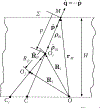Radiative transfer in a discrete random medium adjacent to a half-space with a rough interface
- PMID: 30504992
- PMCID: PMC6258088
- DOI: 10.1016/j.jqsrt.2018.07.016
Radiative transfer in a discrete random medium adjacent to a half-space with a rough interface
Abstract
For a macroscopically plane-parallel discrete random medium, the boundary conditions for the specific coherency dyadic at a rough interface are derived. The derivation is based on a modification of the Twersky approximation for a scattering system consisting of a group of particles and the rough surface, and reduces to the solution of the scattering problem for a rough surface illuminated by a plane electromagnetic wave propagating in a discrete random medium with non-scattering boundaries. In a matrix-form setting, the boundary conditions for the specific coherency dyadic imply the boundary conditions for specific intensity column vectors which in turn, yield the expressions for the reflection and transmission matrices. The derived expressions are shown to be identical to those obtained by applying a phenomenological approach based on a facet model to the solution of the scattering problem for a rough surface illuminated by a plane electromagnetic wave.
Figures






Similar articles
-
Electromagnetic scattering by discrete random media. II: The coherent field.J Quant Spectrosc Radiat Transf. 2019 Jun;230:86-105. doi: 10.1016/j.jqsrt.2019.03.011. Epub 2019 Mar 19. J Quant Spectrosc Radiat Transf. 2019. PMID: 31186585 Free PMC article.
-
An overview of methods for deriving the radiative transfer theory from the Maxwell equations. II: Approach based on the Dyson and Bethe-Salpeter equations.J Quant Spectrosc Radiat Transf. 2019 Feb;224:25-36. doi: 10.1016/j.jqsrt.2018.10.032. Epub 2018 Oct 23. J Quant Spectrosc Radiat Transf. 2019. PMID: 30713354 Free PMC article.
-
First-principles modeling of electromagnetic scattering by discrete and discretely heterogeneous random media.Phys Rep. 2016 May 16;632:1-75. doi: 10.1016/j.physrep.2016.04.002. Epub 2016 Apr 12. Phys Rep. 2016. PMID: 29657355 Free PMC article.
-
Vector radiative transfer equation for arbitrarily shaped and arbitrarily oriented particles: a microphysical derivation from statistical electromagnetics.Appl Opt. 2002 Nov 20;41(33):7114-34. doi: 10.1364/ao.41.007114. Appl Opt. 2002. PMID: 12463259
-
Electromagnetic scattering by discrete random media. IV: Coherent backscattering.J Quant Spectrosc Radiat Transf. 2019 Oct;236:106565. doi: 10.1016/j.jqsrt.2019.07.008. Epub 2019 Jul 8. J Quant Spectrosc Radiat Transf. 2019. PMID: 32454537 Free PMC article.
References
-
- Mishchenko MI. Electromagnetic scattering by particles and particle groups: an introduction. Cambridge, UK: Cambridge University Press; 2014. <https://www.giss.nasa.gov/staff/mmishchenko/publications/Book_4.pdf>
-
- Mishchenko MI. Directional radiometry and radiative transfer: the convoluted path from centuries-old phenomenology to physical optics. J Quant Spectrosc Radiat Transfer 2014;146:4–33.
-
- Soubret A, Berginc G. Electromagnetic wave scattering from a random layer with rough interfaces I: Coherent field. arXiv:physics/0312133 [physics.ao-ph].
-
- Soubret A, Berginc G. Electromagnetic wave scattering from a random layer with rough interfaces II: Diffusive intensity. arXiv:physics/0312136 [physics.ao-ph].
Grants and funding
LinkOut - more resources
Full Text Sources
